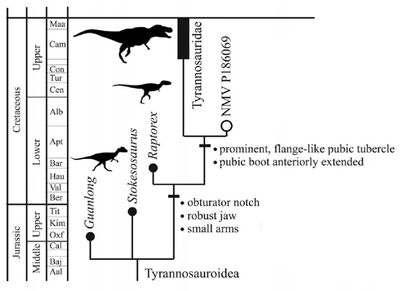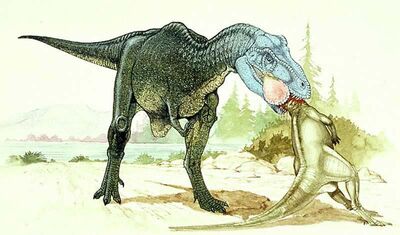
A cladogram of Tyrannosauroidea
Tyrannosauridae's origin is a matter of debate. They probably evolved from three fingered, smaller, feathered, agile, smarter (at least compared to the Tyrannosauridae) animals.
Origin[]
It probably shared a most recent common ancestor with a newly discovered tyrannosauroid from Australia called NMV P186069 (see right). Scientists can tell because certain characteristics only point to certain families in higher taxonomic ranks. The family Tyrannosauridae and the Australian tyrannosauroid both share characteristics of prominent, flange-like pubic tubercles and the pubic boot is anteriorly extended (It's a good thing that NMV P186069's pelvis was preserved or else we might of never knew about it's taxonomy within Tyrannosauroidea (also, without a pelvis you can't tell if a dinosaur is an ornithiscian or a saurischian)).
Reason for the Evolution of Tyrannosauridae[]
Around 80 million years ago most of the carnosaurs were wiped out in the Northern Hemisphere. This was an advantage for the tyrannosauroids. Since the niche had to be replaced by some theropod (Since a niche belonged to the Carnosauria then an animal similar to carnosaurs (e.g: tyrannosaur) would have to take the niche) the tyranosaurs took it.
Likely Candidate for the Ancestor of all Tyrannosaurs[]
The likely candidate for the direct evolution to the tyrannosaurids might have been an animal similar to the dryptosaurids (Dryptosaurus). They share the characteristics such as small arms, large bodies and big heads compared to their bodies. One such recent animal named Sinotyrannus was a big animal (33 feet or longer similar to Tyrannosaurus bataar) had a big head and there is no time issue, meaning it evolved a long time before the first tyrannosaurid.
